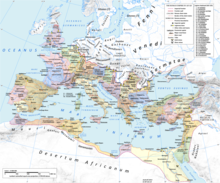Decimus Terentius Scaurianus | |
|---|---|
 | |
| Consul of the Roman Republic | |
| Assumed office 102 or 104 | |
| Personal details | |
| Roman tribe | Claudia |
| Military service | |
| Allegiance | |
| Rank | Praetor Legatus |
| Commands | Governor of Dacia |
| Battles/wars | Second Dacian War |
Decimus Terentius Scaurianus was a Roman senator and general active in the late 1st and early 2nd centuries AD. He was suffect consul in either the year 102 or 104.[1] He worked his way up through increasingly responsible positions. He commanded a legion from 96 to 98 and again during the Second Dacian War. After the war he was military governor of the newly conquered province from 106 to 111. He is known to have been decorated for his military service.
Magistracies

Scaurianus was of plebeian origin. His cursus honorum, the sequential mixture of military and political administrative positions held by aspiring politicians in the early Roman Empire, is known in part from a damaged inscription found at Nemausus (modern Nîmes).[2] The inscription also bears the name of Pompeia Marullus, whom historian Ronald Syme identifies as a relative of Scaurianus.[3] His first recorded office is as a member of the quattuorviri viarum curandarum, the board of four magistrates overseeing road maintenance within the city of Rome. It was one of the four boards that formed the vigintiviri, and membership in one of these four boards was a preliminary and required first step towards entry to the Roman Senate. Next Scaurianus was commissioned military tribune, a middle ranking officer, in Legio I Italica, which at the time was stationed at Novae (modern Svishtov) in the imperial province of Moesia. He served as quaestor in the public province of Achaea, responsible for supervising the state treasury and conducting audits. Upon completion of his quaestorship, Scaurianus was enrolled in the Senate.[4] Although the inscription from Nemausus is incomplete, it attests he held the traditional Republican magistracy of plebeian tribune, another prestigious position which had lost its independence and most of its practical functions, and then he was elected praetor.
Consul and general
Scaurianus was commissioned legatus, or commander, of another legion by Emperor Trajan. The name of the legion is lost; historian Valerie Maxfield dates his tenure as commander of this unknown legion from around 96 to around 98.[5] In either 102 or 104, Scaurianus served at least part of a year as a consul.[1] A consulship was the highest honour of the Roman state and candidates were chosen carefully by the emperor.[6][7] It is probable that Scaurianus commanded a legion in the Second Dacian War from 105 to 106. According to Italian historian Albino Garzetti he served on Trajan's staff for at least a part of the war. He is attested by a number of surviving military diplomas to have been governor of Dacia. According to Werner Eck his tenure extended from 106 to 111, after the conclusion of the war.[8] He vigorously Romanised the new province, concentrating on road building, especially those to the gold mines in eastern Dacia.[9] He was the patron and first governor of Roman Dacia's new capital, Ulpia Traiana Sarmizegetusa.[10]

An inscription from the site reads:
On the command of the emperor Caesar Nerva Traianus Augustus, son of the divine Nerva, was settled the Dacian Colony by Decimus Terentius Scaurianus, its governor.[10]
The inscription from Nemausus records a military decoration or dona militaria which Scaurianus received, an award of four spears. According to Maxfield, this decoration was appropriate to the rank of ex-consul and dates to the Second Dacian War. How he earned these decorations in the war is unknown.[5]
Footnotes
- ^ a b Syme 1997, p. 648.
- ^ CIL XII, 3169
- ^ Syme 1997, p. 646.
- ^ Richard Talbert, The Senate of Imperial Rome (Princeton: University Press, 1984), p. 16
- ^ a b Maxfield 1972, p. 49.
- ^ Smallwood 2010, p. 12.
- ^ Mennen 2011, p. 129.
- ^ Eck 1982, pp. 343–350.
- ^ Garzetti 2014.
- ^ a b "Colonia Ulpia Traiana Augusta Dacica Sarmizegetusa". National Archaeological Record of Romania (RAN). ran.cimec.ro. 2012-08-08. Archived from the original on 2012-10-18. Retrieved 2014-03-20.
References
- Syme, Ronald (1997). Tacitus. Oxford: Clarendon Press. ISBN 978-0-19-814327-7.
- Eck, Werner (1982). "Jahres- und Provinzialfasten der senatorischen Statthalter von 69/70 bis 138/139". Chiron: Mitteilungen der Kommission für Alte Geschichte und Epigraphik des Deutschen Archäologischen Instituts (in German). ISSN 0069-3715.
- Garzetti, Albino (2014). From Tiberius to the Antonines. London: Routledge. ISBN 978-1138019201.
- Maxfield, Valerie (1972). The Dona Militaria of the Roman Army (Thesis). Durham: Durham University. OCLC 912674854. Archived from the original on 28 June 2020. Retrieved 6 August 2018.
- Mennen, Inge (2011). Power and Status in the Roman Empire, AD 193–284. Leiden: Brill. ISBN 978-90-04-20359-4.
- Smallwood, E. Mary (2010). Principates of Nerva, Trajan and Hadrian. Cambridge: Cambridge. ISBN 978-0-521-12894-0.








